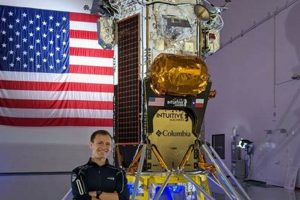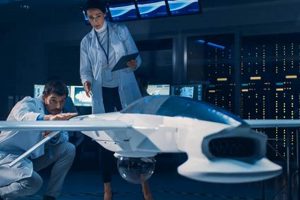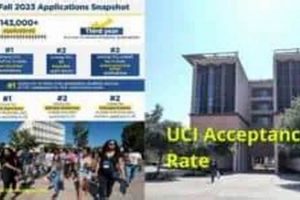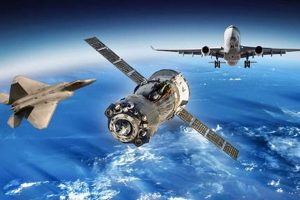The duration of academic programs focused on the design, development, and testing of aircraft and spacecraft typically spans a defined timeframe. These programs equip individuals with the fundamental knowledge and specialized skills required for a career in this technologically advanced field. For instance, a Bachelor of Science degree providing an introductory foundation usually takes a specific amount of time to complete.
The length of these educational commitments reflects the complexity of the subject matter and the need for a thorough understanding of principles like aerodynamics, propulsion, and structural mechanics. Successful completion offers graduates opportunities to contribute to advancements in air travel, space exploration, and national defense. Historically, the structured curriculum has evolved to incorporate emerging technologies and address the evolving demands of the industry.
The following sections will delve deeper into the specific degree levels offered, the coursework involved, potential career paths available to graduates, and factors that may influence the overall duration of study, such as accelerated programs or advanced specializations.
Understanding the timeframe associated with aerospace engineering programs is crucial for effective academic planning and career preparation. These tips offer insights to aid in navigating the educational pathway.
Tip 1: Degree Level Matters: Bachelor’s programs typically require four years of full-time study. Master’s degrees generally add an additional one to three years, while doctoral studies can extend the commitment to five or more years beyond a bachelor’s.
Tip 2: Curriculum Intensity Influences Timeline: Programs with a heavy emphasis on laboratory work, research projects, or specialized electives may require additional time investment compared to those with a more theoretical focus.
Tip 3: Consider Accelerated Programs: Certain institutions offer accelerated options that allow students to complete their degree in a shorter timeframe, often through year-round enrollment or intensive coursework.
Tip 4: Factor in Internship and Co-op Opportunities: Participation in internships or cooperative education programs, while valuable for gaining practical experience, can extend the overall program duration by a semester or a year.
Tip 5: Prior Academic Preparation Can Shorten the Path: Advanced Placement (AP) credits or prior college coursework relevant to the aerospace engineering curriculum may allow students to bypass introductory courses, potentially reducing the overall time to graduation.
Tip 6: Research Program Requirements Thoroughly: Before enrolling, carefully review the specific curriculum, credit hour requirements, and graduation policies of each program under consideration to accurately estimate the commitment necessary.
Tip 7: External Exams Could Reduce Time: Some programs allow you to test out of classes by external exams. Check which courses are available for you.
By carefully considering these factors, prospective aerospace engineers can develop a realistic timeline for their academic journey and optimize their path toward a successful career in the field.
The concluding sections of this article will summarize the key considerations related to aerospace engineering program durations and offer guidance on making informed decisions about educational investments.
1. Bachelor's Duration
The completion of a Bachelor of Science degree directly correlates with the duration of formal education in aerospace engineering. A standard undergraduate curriculum designed to impart fundamental knowledge in areas such as fluid dynamics, thermodynamics, and control systems generally requires four years of full-time study. This timeframe is considered the baseline measurement for understanding the overall time investment necessary to enter the field. For example, a prospective aerospace engineer must allocate approximately four years to acquire the necessary theoretical foundation, allowing them to pursue advanced studies or entry-level positions in the industry.
The importance of the Bachelor’s duration stems from its role as a prerequisite for further specialization and professional licensure in many jurisdictions. Additionally, internships and co-operative education programs, often undertaken during the undergraduate years, can extend the time spent in academic training but provide invaluable practical experience. The structure of a typical Bachelor’s program provides a scaffolded approach to learning, starting with foundational mathematics and physics courses before progressing to more specialized aerospace topics. This structured progression necessitates a multi-year commitment to ensure adequate comprehension and mastery of the subject matter.
In summary, the Bachelor’s duration is a crucial component in determining the total time invested in an aerospace engineering education. While variables such as prior academic credits or participation in co-op programs may influence the exact timeframe, the four-year Bachelor’s program serves as a fundamental benchmark. Understanding this connection allows individuals to effectively plan their academic pathways and career aspirations within the aerospace engineering domain.
2. Master's Extension
The pursuit of a Master’s degree represents a significant extension to the base duration of an aerospace engineering education. This advanced degree allows for specialization and a deeper dive into specific areas within the field, consequently impacting the total time dedicated to academic preparation.
- Specialization and Focus
A Master’s program enables engineers to concentrate on specific domains such as propulsion, aerodynamics, or structural analysis. This focused study typically requires an additional one to three years of academic work, extending the overall duration of formal training beyond the standard four-year Bachelor’s program. Examples include specializing in computational fluid dynamics or satellite systems engineering. The deeper the specialization, the longer the program becomes.
- Research Opportunities
Many Master’s programs incorporate a research component, often culminating in a thesis or dissertation. This research phase can significantly influence the overall timeline, potentially adding a year or more to the program’s length. Research-intensive tracks in areas such as advanced materials or hypersonic flight often require substantial laboratory work and data analysis, thereby extending the commitment. The availability of resources and faculty mentorship also plays a crucial role in determining the pace of research.
- Industry Relevance and Career Advancement
The extended duration of a Master’s program often translates to enhanced career prospects and increased earning potential. Employers in the aerospace sector frequently seek candidates with advanced degrees for specialized roles and leadership positions. The additional time invested in a Master’s provides graduates with a competitive edge in the job market and opens doors to more complex and challenging engineering tasks. For example, a design engineer with a Master’s may lead a project developing a new type of aircraft wing.
- Coursework and Curriculum Depth
Master’s programs feature advanced coursework that builds upon the foundational knowledge acquired during the Bachelor’s degree. This coursework delves into more intricate concepts and applications, requiring a more significant time commitment. The intensity and breadth of the curriculum influence the program duration, with some programs offering a broader range of electives and specializations than others. For example, coursework on advanced control systems or space mission design contributes to both theoretical knowledge and practical skills.
In summation, the “Master’s Extension” in aerospace engineering substantially influences the total duration of academic study. The decision to pursue a Master’s reflects a commitment to specialized knowledge and career advancement, factors which directly correlate with the extended time investment required for completion. The program extends into advanced coursework, intensive research and enhances career prospects.
3. Doctoral Commitment
The pursuit of a doctoral degree in aerospace engineering represents the most extensive commitment to academic study within the field. The duration of this commitment is directly related to the breadth and depth of research, the complexity of the dissertation, and the requirements of the specific university.
- Research Scope and Originality
Doctoral programs require students to conduct original research that advances the existing body of knowledge. The scope of this research dictates the time needed for completion. For example, a project involving the development of a novel propulsion system may require extensive experimentation and analysis, extending the program duration. Similarly, research addressing unresolved issues in hypersonic flight or advanced materials demands rigorous investigation and iterative refinement.
- Dissertation Complexity
The dissertation serves as the culminating work of a doctoral student and typically represents a substantial intellectual contribution. The complexity of the research question, the methodology employed, and the analysis required directly influence the time needed to complete the dissertation. Dissertations involving sophisticated numerical simulations or extensive experimental data collection often require several years of dedicated effort.
- University Requirements and Milestones
Universities impose specific requirements and milestones that doctoral students must meet to progress through the program. These may include comprehensive examinations, proposal defenses, and regular progress reports. The stringency of these requirements and the frequency of evaluations impact the overall duration of the program. For instance, a university requiring multiple rounds of revisions for a dissertation proposal may inadvertently extend the student’s time to completion.
- Funding and Resources Availability
The availability of funding and access to essential resources, such as laboratory equipment and computational facilities, significantly affect the pace of doctoral research. Students with consistent funding and access to necessary resources can typically complete their research more efficiently than those facing financial constraints or resource limitations. Delays in funding or equipment procurement can substantially prolong the time required to complete a doctoral program.
In conclusion, the doctoral commitment in aerospace engineering is multifaceted and demanding. The length of study, often exceeding five years beyond a bachelor’s degree, reflects the need for rigorous research, in-depth analysis, and the fulfillment of institutional requirements. The dedication of time and resources associated with doctoral studies directly correlates with the potential for significant contributions to the field of aerospace engineering.
4. Curriculum Intensity
The depth and breadth of coursework, practical training, and research embedded within an aerospace engineering program significantly influence its duration. The intensity of the curriculum directly correlates with the “aerospace engineering how many years” question, affecting both undergraduate and graduate studies.
- Course Load and Specialization
A heavy course load, characterized by numerous required courses and specialized electives, extends the time needed to complete a program. For example, a curriculum emphasizing both theoretical aerospace principles and hands-on design projects in areas like propulsion, aerodynamics, and control systems demands a more extended period of study to ensure comprehensive understanding and practical application. Programs focusing on specialized areas also can lengthen the amount of time that the program takes to complete.
- Laboratory Work and Practical Application
Aerospace engineering programs inherently require substantial laboratory work and practical application to reinforce theoretical concepts. Extensive wind tunnel testing, structural analysis simulations, and hands-on experience with flight control systems necessitate additional time. The more emphasis placed on these practical components, the longer the program duration.
- Research Project Requirements
Many aerospace engineering curricula, particularly at the graduate level, incorporate research projects as a core component. These projects demand considerable time investment for literature reviews, experimental design, data collection, analysis, and report writing. The scope and complexity of the research project contribute directly to the overall time commitment of the program.
- Accreditation Standards and Curriculum Content
Accreditation bodies often set specific requirements for curriculum content and learning outcomes. Meeting these standards can necessitate a more rigorous and comprehensive curriculum, thereby influencing the program’s length. For instance, a program adhering to stringent accreditation guidelines may incorporate additional coursework or laboratory experiences to ensure students meet required competencies.
In summary, the intensity of the curriculum, encompassing course load, practical training, research demands, and accreditation standards, significantly impacts the “aerospace engineering how many years” equation. Programs with a more rigorous and comprehensive curriculum naturally require a longer time commitment to ensure students acquire the necessary knowledge and skills for success in the field.
5. Accelerated Options
The availability of accelerated options directly influences the timeframe associated with completing aerospace engineering programs. These options are designed to compress the standard curriculum into a shorter duration, addressing the “aerospace engineering how many years” question with an alternative approach. This compressed structure may involve year-round enrollment, intensive coursework, or a focus on core competencies, reducing the overall time spent in formal education. For example, a traditional four-year Bachelor of Science program might be completed in three years through continuous enrollment and a concentrated curriculum. This offers a faster entry into the professional aerospace sector, especially for individuals with clear career goals and the capacity for intensive study. The effectiveness of this approach depends on several factors, including the student’s prior academic preparation, learning style, and commitment to a demanding schedule.
These programs can benefit students looking to expedite their education for various reasons, such as career advancement or reduced tuition costs. However, accelerated options demand a greater dedication to coursework and may limit opportunities for extracurricular activities or internships. An accelerated Master’s program, for example, could allow a working engineer to gain advanced specialization in a shorter period, enhancing their skill set and career prospects. It is important to carefully consider the trade-offs between time saved and the potential impact on the depth of learning and overall experience. The rigorous pace necessitates strong time management and study skills, making it a suitable option for motivated and self-disciplined individuals. The benefits of this approach can be significant, especially in a rapidly evolving field like aerospace engineering, where staying current with the latest technologies and practices is essential.
In summary, accelerated options offer a viable pathway for reducing the “aerospace engineering how many years” commitment. The suitability of this path depends on individual circumstances and preferences. Careful consideration of the program structure, personal learning style, and career goals is essential before opting for an accelerated approach. While these options provide a faster track to degree completion, they require a high level of dedication and commitment to ensure a successful outcome. The choice between a traditional and accelerated program should be a well-informed decision based on a thorough evaluation of the potential benefits and challenges.
6. Experience Impacts
Practical experience significantly influences the “aerospace engineering how many years” equation. While formal education provides the theoretical foundation, hands-on experience shapes the understanding and application of these principles, affecting the overall time required to achieve professional competency. Internships, co-operative education programs, research assistantships, and entry-level positions contribute to this practical dimension. These experiences supplement classroom learning, providing real-world context and skills refinement. For example, an engineer who has completed multiple internships at aerospace companies might require less on-the-job training upon graduation compared to someone without such experience, effectively accelerating their career progression and reducing the time spent in a purely learning phase after their formal studies are complete.
The impact of experience extends beyond simply shortening the initial training period. Individuals with relevant experience are often more competitive in the job market, securing positions that allow them to contribute meaningfully from an earlier stage. Furthermore, practical exposure can inform decisions about specialization within aerospace engineering. A student who initially intended to focus on propulsion systems might discover a passion for structural analysis after an internship, leading them to adjust their academic path. This informed shift can optimize their learning and career trajectory, potentially leading to faster advancement within their chosen field. For example, a co-op program where a student rotates through different departments in a spacecraft manufacturing facility can provide invaluable insight into various engineering disciplines.
In conclusion, “Experience Impacts” functions as a crucial modifier within the “aerospace engineering how many years” equation. It represents a variable that can compress or enhance the learning curve, influence career decisions, and accelerate professional development. The absence of relevant experience can extend the time required to reach a specific level of expertise, while ample experience can expedite the journey. Recognizing the importance of practical application and actively seeking opportunities to gain hands-on knowledge are critical steps for aspiring aerospace engineers aiming to optimize their learning trajectory and achieve their career goals efficiently.
Frequently Asked Questions
This section addresses common inquiries regarding the time commitment associated with aerospace engineering education. The information provided aims to offer clarity and guidance for prospective students and professionals in the field.
Question 1: How long does it typically take to complete a Bachelor of Science in Aerospace Engineering?
A Bachelor of Science in Aerospace Engineering generally requires four years of full-time study. This timeframe assumes students maintain a consistent academic progress and fulfill all curriculum requirements within the prescribed schedule.
Question 2: How much additional time is needed to obtain a Master’s degree in Aerospace Engineering after completing a Bachelor’s degree?
A Master’s degree in Aerospace Engineering typically adds one to three years of study beyond the Bachelor’s degree. The precise duration depends on the specific program, specialization chosen, and whether a thesis or research project is required.
Question 3: What is the estimated duration for completing a doctoral program in Aerospace Engineering?
Doctoral programs in Aerospace Engineering generally require five or more years of study beyond a Bachelor’s degree. The time commitment is significantly influenced by the scope and complexity of the dissertation research, as well as the university’s specific requirements.
Question 4: Can an aerospace engineering degree be completed in a shorter timeframe through accelerated programs?
Yes, certain institutions offer accelerated options that allow students to complete their degrees in a reduced timeframe. These programs often involve year-round enrollment, intensive coursework, or a focus on core competencies, condensing the standard curriculum.
Question 5: Does prior work experience affect the duration of an aerospace engineering program?
Prior relevant work experience, such as internships or co-operative education programs, can potentially reduce the time needed to acquire professional competency after graduation. The practical skills and knowledge gained through these experiences can accelerate the learning curve in subsequent roles.
Question 6: What factors beyond the curriculum can influence the overall duration of study?
External factors, such as funding availability, access to resources, and the need to balance academic commitments with personal obligations, can influence the overall duration of study. These factors should be carefully considered when planning an academic pathway in aerospace engineering.
This information provides a general overview of the time commitment associated with aerospace engineering education. Individual circumstances and program specifics can influence the actual duration of study. Therefore, prospective students are advised to thoroughly research program requirements and consider their personal circumstances when planning their academic path.
The following section offers concluding remarks on the “aerospace engineering how many years” topic.
Conclusion
The preceding sections have examined the multifaceted nature of the “aerospace engineering how many years” question. From the foundational four-year Bachelor of Science degree to the extended commitments of Master’s and doctoral programs, the duration of formal education is influenced by curriculum intensity, research requirements, and the availability of accelerated options. Practical experience gained through internships and co-operative education programs further impacts the overall trajectory toward professional competency. This analysis underscores the importance of carefully considering individual goals, academic preparation, and program structure when planning an educational pathway in aerospace engineering.
The time invested in aerospace engineering education represents a significant commitment to intellectual growth and career development. As the field continues to evolve, driven by technological advancements and global challenges, the value of a well-structured and comprehensive educational foundation remains paramount. Individuals contemplating a career in this dynamic discipline are encouraged to thoroughly research program options, assess their personal circumstances, and embrace the challenges and opportunities that lie ahead. The pursuit of knowledge and expertise in aerospace engineering serves as a critical investment in shaping the future of air travel, space exploration, and technological innovation.







